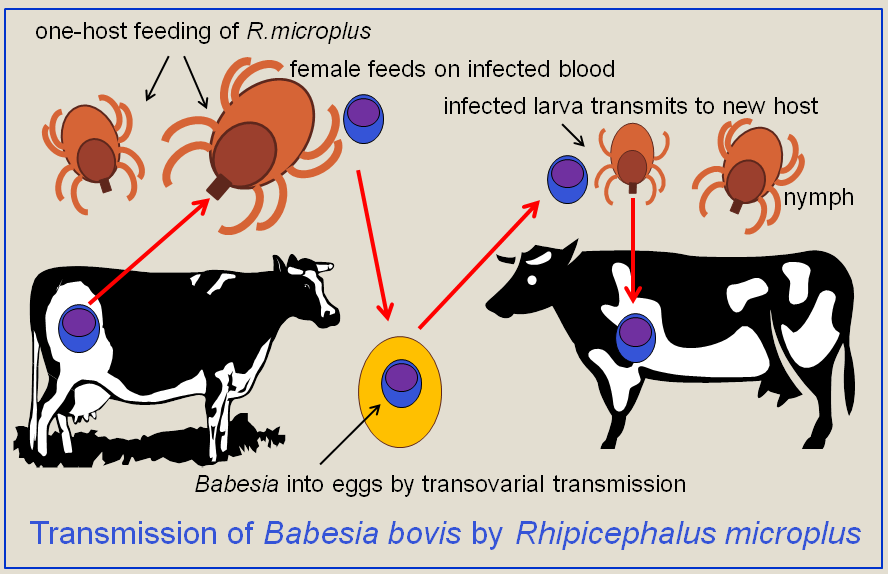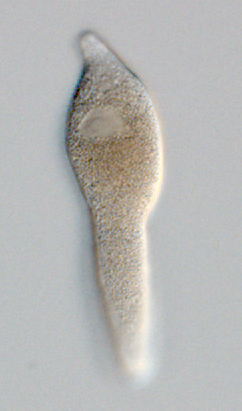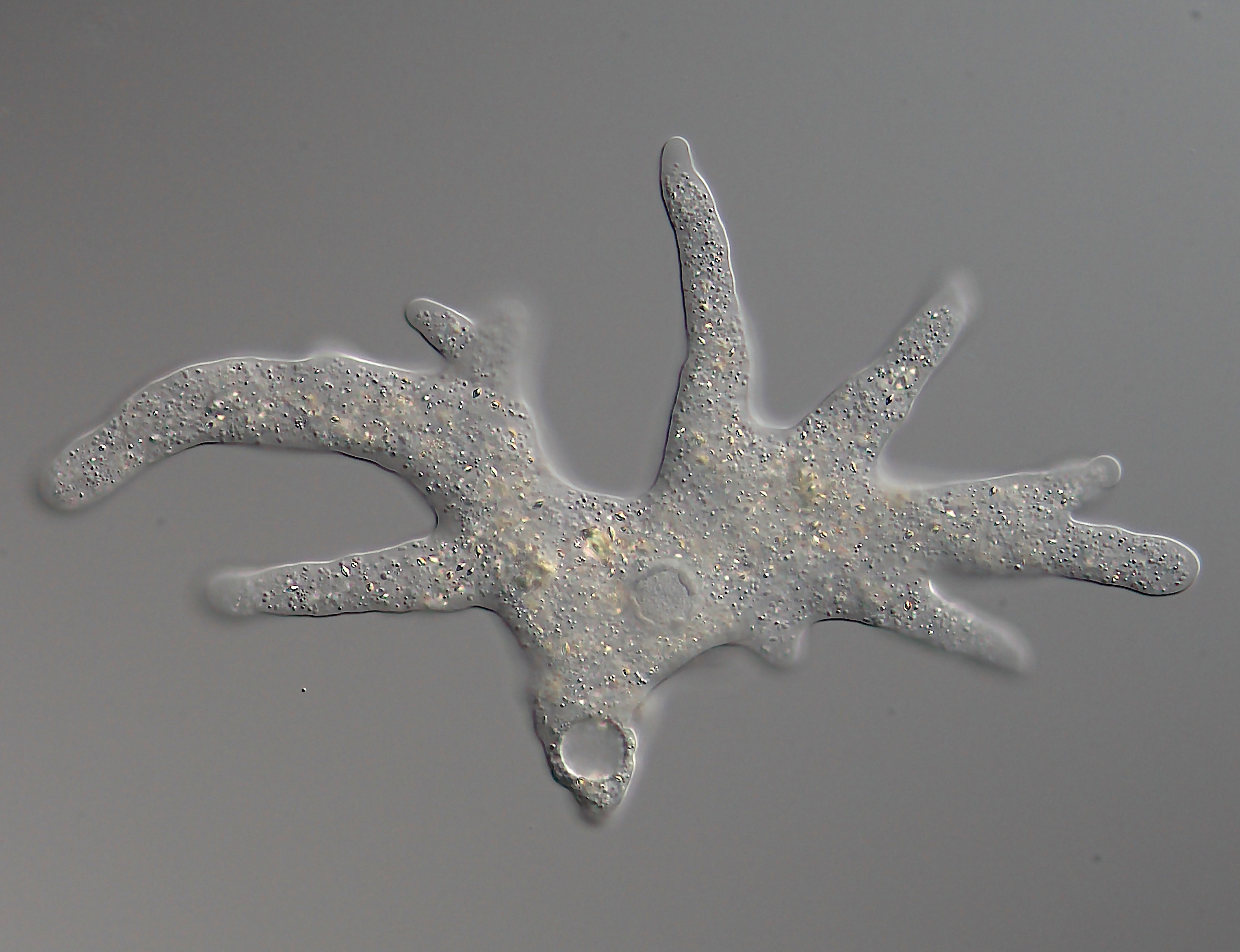|
Apicomplexa Genera
The Apicomplexa (also called Apicomplexia; single: apicomplexan) are organisms of a large phylum of mainly parasitic alveolates. Most possess a unique form of organelle structure that comprises a type of non-photosynthetic plastid called an apicoplastwith an apical complex membrane. The organelle's apical shape is an adaptation that the apicomplexan applies in penetrating a host cell. The Apicomplexa are unicellular and spore-forming. Most are obligate endoparasites of animals, except '' Nephromyces'', a symbiont in marine animals, originally classified as a chytrid fungus, and the Chromerida, some of which are photosynthetic partners of corals. Motile structures such as flagella or pseudopods are present only in certain gamete stages. The Apicomplexa are a diverse group that includes organisms such as the coccidia, gregarines, piroplasms, haemogregarines, and plasmodia. Diseases caused by Apicomplexa include: * Babesiosis ('' Babesia'') * Malaria (''Plasmodium'') * Cr ... [...More Info...] [...Related Items...] OR: [Wikipedia] [Google] [Baidu] |
Aconoidasida
The Aconoidasida are a Class (biology), class of apicomplexan parasites coined by Mehlhorn ''et al'' in 1980. Description Organisms in this class bear a tip at one end of their outer membrane. This apical complex includes vesicles called rhoptries and micronemes, which open at the anterior of the cell. These secrete enzymes that allow the parasite to enter other cells. The tip is surrounded by a band of microtubules, called the polar ring. As the name indicates, Aconoidasida (from Greek language, Greek: negative prefix ''a-'' = "lacking") lack a conoid (organelle), conoid (they do have one only during the ookinete stage) in contrast to the class Conoidasida which have one throughout their life cycle. See also *Haemosporidiasina References Aconoidasida, Apicomplexa classes {{Apicomplexa-stub ... [...More Info...] [...Related Items...] OR: [Wikipedia] [Google] [Baidu] |
Chytrid
Chytridiomycota are a division of zoosporic organisms in the kingdom (biology), kingdom Fungi, informally known as chytrids. The name is derived from the Ancient Greek ('), meaning "little pot", describing the structure containing unreleased zoospores. Chytrids are one of the earliest diverging fungal lineages, and their membership in kingdom Fungi is demonstrated with chitin cell walls, a posterior whiplash flagellum, absorptive nutrition, use of glycogen as an energy storage compound, and synthesis of lysine by the -amino adipic acid (AAA) pathway. Chytrids are saprobic, degrading refractory materials such as chitin and keratin, and sometimes act as parasites. There has been a significant increase in the research of chytrids since the discovery of ''Batrachochytrium dendrobatidis'', the causal agent of chytridiomycosis. Classification Species of Chytridiomycota have traditionally been delineated and classified based on development, morphology, substrate, and method of zoospor ... [...More Info...] [...Related Items...] OR: [Wikipedia] [Google] [Baidu] |
Malaria
Malaria is a Mosquito-borne disease, mosquito-borne infectious disease that affects vertebrates and ''Anopheles'' mosquitoes. Human malaria causes Signs and symptoms, symptoms that typically include fever, Fatigue (medical), fatigue, vomiting, and headaches. In severe cases, it can cause jaundice, Epileptic seizure, seizures, coma, or death. Symptoms usually begin 10 to 15 days after being bitten by an infected ''Anopheles'' mosquito. If not properly treated, people may have recurrences of the disease months later. In those who have recently survived an infection, reinfection usually causes milder symptoms. This partial Immunity (medical), resistance disappears over months to years if the person has no continuing exposure to malaria. The mosquitoes themselves are harmed by malaria, causing reduced lifespans in those infected by it. Malaria is caused by protozoa, single-celled microorganisms of the genus ''Plasmodium''. It is spread exclusively through bites of infected female ... [...More Info...] [...Related Items...] OR: [Wikipedia] [Google] [Baidu] |
Babesia
''Babesia'', also called ''Nuttallia'', is an apicomplexan parasite that infects red blood cells and is transmitted by ticks. Originally discovered by Romanian bacteriologist Victor Babeș in 1888; over 100 species of ''Babesia'' have since been identified. ''Babesia'' comprises more than 100 species of tick-borne parasites that infect erythrocytes (red blood cells) in many vertebrate hosts. ''Babesia'' species infect livestock worldwide, wild and domestic vertebrate animals, and occasionally humans, where they cause the disease babesiosis. In the United States, ''B. microti'' is the most common strain of the few that have been documented to cause disease in humans. Classification ''Babesia'' is a protozoan parasite found to infect vertebrate animals, mostly livestock mammals and birds, but also occasionally humans. Common names of the disease that ''B. microti'' causes are Texas cattle fever, redwater fever, tick fever, and Nantucket fever. The disease it ... [...More Info...] [...Related Items...] OR: [Wikipedia] [Google] [Baidu] |
Babesiosis
Babesiosis or piroplasmosis is a malaria-like parasitic disease caused by infection with a eukaryotic parasite in the order Piroplasmida, typically a ''Babesia'' or '' Theileria'', in the phylum Apicomplexa. Human babesiosis transmission via tick bite is most common in the Northeastern and Midwestern United States and parts of Europe, and sporadic throughout the rest of the world. It occurs in warm weather. People can get infected with ''Babesia'' parasites by the bite of an infected tick, by getting a blood transfusion from an infected donor of blood products, or by congenital transmission (an infected mother to her baby). Ticks transmit the human strain of babesiosis, so it often presents with other tick-borne illnesses such as Lyme disease. After trypanosomes, ''Babesia'' is thought to be the second-most common blood parasite of mammals. They can have major adverse effects on the health of domestic animals in areas without severe winters. In cattle, the disease is known ... [...More Info...] [...Related Items...] OR: [Wikipedia] [Google] [Baidu] |
Plasmodiidae
The Plasmodiidae are a family of apicomplexan parasites, including the type genus ''Plasmodium'', which is responsible for malaria. This family was erected in 1903 by Mesnil and is one of the four families in the order Haemospororida. Diagnostic criteria The diagnostic criteria of the Plasmodiidae are: * Macrogametes and microgamonts develop independently * Meiosis is absent * Microgametocyte produces eight flagellated microgametes * Zygote is motile (known as an ookinete) * Conoid present in ookinete stage only * Sporozoites naked in oocyst (that is without a sporocyst) * Sporozoites have three walls * Heteroxenous: merogony and gamogony occur in vertebrate host, and fertilization and sporogony in definitive host (a blood-sucking insect) * Hemozoin pigment is produced Taxonomy The family Plasmodiidae has three sister taxa in the order Haemospororida: the families Garniidae, Haemoproteidae, and Leucocytozoidae. The Haemoproteidae and the Plasmodiidae both pr ... [...More Info...] [...Related Items...] OR: [Wikipedia] [Google] [Baidu] |
Haemogregarine
''Adeleorina'' is a suborder of parasites in the phylum Apicomplexa. History Léger proposed this taxon in 1911. The first species identified was '' Dactylosoma ranarum'' by Lankester (1871) in a frog in Europe. It was initially called ''Undulina ranarum'', but this was changed in 1882 to ''Drepanidium ranarum''. This species was subsequently moved to the genus ''Dactylosoma''. Canine hepatozoonosis was first described in India in 1905 by James. The organism was named ''Leukocytozoon canis''. The vector was identified in 1907 by Christopher to be the brown dog tick (''Rhipicephalus sanguineus''). The genus '' Hepatozoon'' was created by Miller in 1908 for a parasite of the white rat (''Rattus norvegicus'') that underwent merogony in the liver and sporogony in the mite '' Laelap echidinus''. Ledger initially placed this genus in the family Haemogregarinidae, but Wenyon subsequently removed it and placed it in the newly created taxon Hepatozoidae in 1926. Life cycle All spec ... [...More Info...] [...Related Items...] OR: [Wikipedia] [Google] [Baidu] |
Piroplasm
Piroplasmida is an order of parasites in the phylum Apicomplexa. They divide by binary fission and as sporozoan parasites they possess sexual and asexual phases (sexual reproduction occurs in the tick gut). They include the tick parasites ''Babesia'' and '' Theileria''. Description They are minute rounded or pyriform parasites found within erythrocytes, or other circulating or endothelial cells of vertebrates, where they reproduce by merogony. The trophozoite stage is separated from erythrocyte by a single membrane. This distinguishes them from other blood parasites that usually have at least two membranes. An apical complex with a polar ring and rhopteries occurs, but without a conoid and usually without associated pellicular microtubules. They lack flagella and do not form either oocysts or spores. The known vectors are ticks or leeches in which they undergo sporogony; sexual reproduction probably occurs in the vector. See also * Babesiosis Babesiosis or pirop ... [...More Info...] [...Related Items...] OR: [Wikipedia] [Google] [Baidu] |
Gregarine
The gregarines are a group of Apicomplexan alveolates, classified as the Gregarinasina or Gregarinia. The large (roughly half a millimeter) parasites inhabit the intestines of many invertebrates. They are not found in any vertebrates. Gregarines are closely related to both '' Toxoplasma'' and ''Plasmodium'', which cause toxoplasmosis and malaria, respectively. Both protists use protein complexes similar to those that are formed by the gregarines for gliding motility and for invading target cells. This makes the gregarines excellent models for studying gliding motility, with the goal of developing treatment options for both toxoplasmosis and malaria. Thousands of different species of gregarine are expected to be found in insects, and 99% of these gregarine species still need to be described. Each insect species can be the host of multiple gregarine species. One of the most-studied gregarines is '' Gregarina garnhami''. In general, gregarines are regarded as a very successful group ... [...More Info...] [...Related Items...] OR: [Wikipedia] [Google] [Baidu] |
Coccidia
Coccidia (Coccidiasina) are a subclass of microscopic, spore-forming, single-celled obligate intracellular parasites belonging to the apicomplexan class Conoidasida. As obligate intracellular parasites, they must live and reproduce within an animal cell. Coccidian parasites infect the intestinal tracts of animals, and are the largest group of apicomplexan protozoa. Infection with these parasites is known as coccidiosis. Coccidia can infect all mammals, some birds, some fish, some reptiles, and some amphibians. Most species of coccidia are species-specific in their host. An exception is '' Toxoplasma gondii'', which can infect all mammals, although it can only undergo sexual reproduction in cats. Depending on the species of coccidia, infection can cause fever, vomiting, diarrhea, muscle pain, and nervous system effects and changes to behavior, and may lead to death. Healthy adults may recover without medication—but those who are immunocompromised or young almost certainly ... [...More Info...] [...Related Items...] OR: [Wikipedia] [Google] [Baidu] |
Gamete
A gamete ( ) is a Ploidy#Haploid and monoploid, haploid cell that fuses with another haploid cell during fertilization in organisms that Sexual reproduction, reproduce sexually. Gametes are an organism's reproductive cells, also referred to as sex cells. The name gamete was introduced by the German cytologist Eduard Strasburger in 1878. Gametes of both mating individuals can be the same size and shape, a condition known as isogamy. By contrast, in the majority of species, the gametes are of different sizes, a condition known as anisogamy or heterogamy that applies to humans and other mammals. The human ovum has approximately 100,000 times the volume of a single human sperm cell. The type of gamete an organism produces determines its sex and sets the basis for the sexual roles and sexual selection. In humans and other species that produce two Morphology (biology), morphologically distinct types of gametes, and in which Gonochorism, each individual produces only one type, a femal ... [...More Info...] [...Related Items...] OR: [Wikipedia] [Google] [Baidu] |
Pseudopod
A pseudopod or pseudopodium (: pseudopods or pseudopodia) is a temporary arm-like projection of a eukaryotic cell membrane that is emerged in the direction of movement. Filled with cytoplasm, pseudopodia primarily consist of actin filaments and may also contain microtubules and intermediate filaments. Pseudopods are used for motility and ingestion. They are often found in amoebas. Different types of pseudopodia can be classified by their distinct appearances. Lamellipodia are broad and thin. Filopodia are slender, thread-like, and are supported largely by microfilaments. Lobopodia are bulbous and amoebic. Reticulopodia are complex structures bearing individual pseudopodia which form irregular nets. Axopodia are the phagocytosis type with long, thin pseudopods supported by complex microtubule arrays enveloped with cytoplasm; they respond rapidly to physical contact. Generally, several pseudopodia arise from the surface of the body, (''polypodial'', for example, '' Amoeba p ... [...More Info...] [...Related Items...] OR: [Wikipedia] [Google] [Baidu] |




